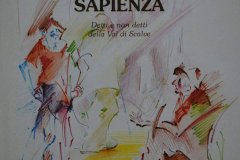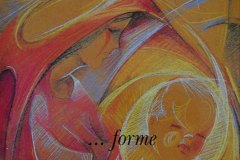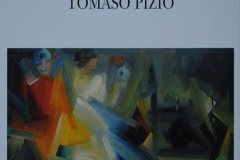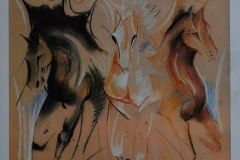Pizio’s artistic work was varied and extensive and many books, catalogs and editorial articles celebrated him and his career.
Some of the best-known publications, in which the artist actively participated, are Antica sapienza, Colori e forme di Tomaso Pizio, Disegni e bozzetti di Tomaso Pizio – Il cammino della vita.
Antica sapienza (1999) collects, as the subtitle suggests, the “Sayings and non-sayings of the Val di Scalve”. The central element of the publication is certainly life, strongly tied to its origins, made of sacrifice, moods, sensations and stimuli: the great human authenticity of the artist, his vitality and his passion are expressed in a constant union between sign and writing.
Every draft, every sketch, every drawing acquires truthfulness and genuineness thanks to the captions that report the culture and the tradition of the Valley.
It is a delicate and at the same time frank representation of the life of each one of us; the anxieties and dreams are concentrated here, respectfully portrayed by Pizio.
Colori e… forme (1995) is an interesting volume that lends itself to a double reading. One can enjoy paintings and drawings and above all those peculiarities that have made Pizio’s art something unique: the chromatic matrix and the strength of signs. These two constants are affirmed and confirmed in every work, be it pictorial, graphic or sculptural.
Il cammino della vita (1983), through the collection of drawings and sketches, welcomes the sign in its most fragile and clean meaning. The sign is a sort of confession, a sincere language, in the essential contrast of black and white and in the immediacy of the translation from abstract thought or emotion to the concrete fact of the legible work.
The ideas in constant ferment follow one another tumultuously, but thanks to Pizio’s manual and sensitive skill he quickly fixes them on paper, offering the viewer a reflection on life.
The latest catalog, Tomaso Pizio – Lo sguardo di un artista, published in 2018 by Grafica & Arte with writings by Amanzio Possenti, offers as complete an overview as possible of Pizio’s artistic life. It has been conceived as an inner journey, so that the reader approaching Pizio’s art for the first time can better understand it.
The works, mostly unpublished, showed deep and careful pictorial, sculptural and graphic studies.
The dynamic sign and the strength of color were the hallmarks of his art and in all these catalogs it is perfectly demonstrated.



